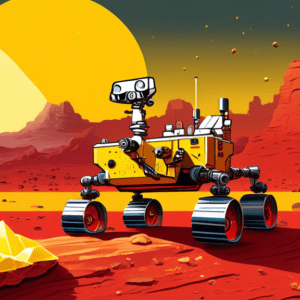Sulfur Crystals Discovered in Martian Rock by Curiosity Rover: Evidence of Ancient Water?
A Significant Find
The Curiosity rover, NASA’s intrepid explorer on Mars, has made another remarkable discovery – sulfur crystals embedded within a Martian rock. This finding, announced recently, has sent ripples of excitement through the scientific community as it could potentially provide more clues about the Red Planet’s watery past and its potential for hosting life.
Curiosity’s Journey and the Discovery Site
Since its arrival in Mars’ Gale Crater in 2012, the Curiosity rover has been tirelessly exploring the Martian surface, uncovering evidence of past habitability. The rover’s current location is Mount Sharp, a towering mountain within the crater. It’s here, in a region characterized by sulfate-rich rocks, that Curiosity stumbled upon these intriguing crystals.
The Significance of Sulfur Crystals
The presence of sulfur crystals, particularly in this geological context, holds immense significance. On Earth, such crystals are often formed in watery environments where water, rich in dissolved minerals, evaporates over time, leaving behind these crystalline structures. This process is similar to how salt flats form on our planet.
While the presence of sulfates in Gale Crater was already known, the discovery of distinct sulfur crystals strengthens the evidence pointing towards a watery past. These crystals suggest that water once existed in this region in a more concentrated form, potentially forming shallow lakes or ponds.
Implications for Martian Life
The discovery of these sulfur crystals, coupled with previous evidence of freshwater lakes and rivers in Gale Crater, paints a compelling picture of ancient Mars as a potentially habitable planet. The presence of water, a key ingredient for life as we know it, raises tantalizing questions about whether microbial life could have existed on Mars billions of years ago.
Further Analysis and Exploration
The Curiosity rover is equipped with a suite of advanced scientific instruments that allow it to analyze the chemical composition of Martian rocks and soil. Scientists are currently conducting further investigations on the sulfur crystals using these instruments, hoping to glean more information about the conditions under which they formed and the composition of the ancient Martian water they likely originated from.
The rover’s exploration of Mount Sharp continues, and this latest discovery will undoubtedly guide future exploration efforts. As Curiosity continues its journey, each new finding adds a piece to the puzzle, bringing us closer to understanding the enigmatic history of Mars and its potential for having once harbored life.
Delving Deeper: The Science Behind the Discovery
Understanding the Martian Environment
To fully grasp the significance of finding sulfur crystals on Mars, it’s crucial to understand the Red Planet’s current environment. Today, Mars is a cold, arid desert with a very thin atmosphere. However, evidence suggests that billions of years ago, it may have been a much warmer and wetter place, more conducive to life as we know it.
The Role of Sulfates and Water
Sulfates, like the ones found in Gale Crater, are minerals that contain sulfur and oxygen. Their presence on Mars indicates that liquid water, a key ingredient for life, once existed there. When water evaporates, it leaves behind dissolved minerals, and sulfates are often among them.
The discovery of distinct sulfur crystals adds another layer to this story. While sulfates themselves point to the past presence of water, the formation of well-defined crystals suggests a more specific scenario – the slow evaporation of water in a relatively calm environment, such as a shallow lake or pond.
Curiosity’s Instruments: Unraveling the Past
The Curiosity rover is equipped with several instruments that are crucial for analyzing these sulfur crystals and understanding their significance:
- ChemCam (Chemistry and Camera): This instrument uses a laser to vaporize small portions of rock and analyzes the resulting plasma to determine their chemical composition. ChemCam can help identify the elements present in the sulfur crystals and their surrounding rock matrix.
- APXS (Alpha Particle X-Ray Spectrometer): APXS bombards the target with alpha particles and X-rays to determine its elemental composition. This instrument can provide more detailed information about the minerals present in the crystals, including the types and abundances of different sulfates.
- MAHLI (Mars Hand Lens Imager): This high-resolution camera can capture detailed images of the crystals, revealing their shape, size, and arrangement. These images help scientists understand the conditions under which the crystals formed.
The Bigger Picture: Searching for Signs of Life
The discovery of sulfur crystals, combined with other evidence gathered by Curiosity, strengthens the case for a habitable ancient Mars. While the rover has not yet found definitive proof of past life, its findings continue to fuel the search for life beyond Earth.
The presence of water, even in the form of ancient lakes and ponds, raises exciting possibilities. If microbial life did exist on Mars billions of years ago, it’s possible that evidence of it might be preserved in the sediments or rocks of Gale Crater.
Looking Ahead: Future Exploration and Discoveries
The Curiosity rover’s mission is far from over. As it continues to explore Mount Sharp, scientists are eager to see what other secrets it might uncover. Each new discovery, from sulfur crystals to evidence of past rivers and lakes, brings us closer to understanding the history of Mars and its potential for having once supported life.
This latest finding will undoubtedly guide future exploration efforts, not just by Curiosity but also by upcoming missions, including the Perseverance rover, which is searching for signs of ancient life in a different region of Mars. The search for life beyond Earth is a long and challenging one, but discoveries like these remind us that we are on an incredible journey of exploration and discovery.
